Ceremonial Guard
The Ceremonial Guard (CG) (French: Garde de cérémonie) is an ad hoc military unit in the Canadian Armed Forces that performs the Changing the Guard ceremony on Parliament Hill and posts sentries at Rideau Hall, the residence of the Governor General of Canada, with the National War Memorial being sentried by the National Sentry Program (NSP), which is carried out by different regiments and other units in order of precedence throughout the summer until mid-November.
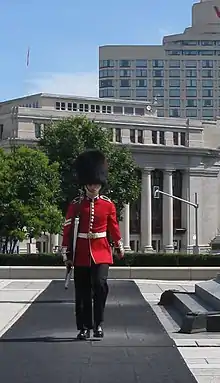
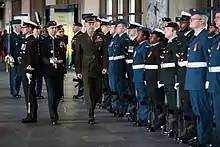
The Ceremonial Guard used to draw principally from the two Primary Reserve (militia) regiments of Foot Guards: the Governor General's Foot Guards (GGFG) from Ottawa (of which the Ceremonial Guard is a sub-unit) and the Canadian Grenadier Guards (CGG) from Montreal, who assumed the duties of the The Canadian Guards upon their disbandment. However, since 2007 the Ceremonial Guard has been staffed with a pan–Canadian Forces approach, drawing members from the Royal Canadian Navy, the Canadian Army, and the Royal Canadian Air Force.
As with any guard unit in the Canadian Forces, uniforms originate from the Queen's Guard, and rank insignia worn on the uniforms generally follow the pattern currently in force. Members of the CG each carry an unloaded Colt Canada C7 rifle.
Origins
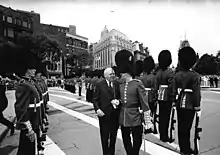
The Ceremonial Guard originated from the Canadian Guards regiment, which served in ceremonial occasions for 20 years in the 1950s and 1960s. It conducted its first guard mount on Parliament Hill on 2 July 1959 in the presence of Elizabeth II. Beginning in the early 1970s, the CGG and the GGFG were added to the Public Duties Detachment (PDD) of the Canadian Guards, due to it being reduced to nil strength in 1970. The PDD, which had been based at CFB Rockcliffe until 1985, changed its name to the Ceremonial Guard in 1979, when the unit became mixed sex due to a compromise by the Department of National Defence as a result of a complaint to a human rights commission on the matter that women could not join the guard due to its status as an infantry unit.[1][2] Since its inception, it has served for over 60 seasons spanning 60 years. In 2020, for the first time since its inception, the summer program was cancelled by order of Commander of the Canadian Army, Lt-General Wayne Eyre, due to the COVID-19 pandemic in Canada.[3]
Unit composition
When the Guard joins together, it consists of the following:
- Public Duties Company
- 1st Division
- 2nd Division
- 3rd Division
- PD Division
- Headquarters Company
- Band of the Ceremonial Guard[4][5]
The total strength is about 350 people, the size of a small battalion. The uniforms worn represent both infantry guards regiments of the Governor General's Foot Guards (GGFG) from Ottawa, and the Canadian Grenadier Guards (CGG) from Montreal. The Public Duties Company is further broken down into platoons and divisions. The Public Duties Company has 4 divisions. A division is about 20–26 soldiers. The CG can also form an ad hoc drill platoon from its ranks.
The Ceremonial Guard maintains no regimental colour nor has it any battle honours of its own as it is not a permanent unit in the Canadian Forces' order of battle. The only colours flown in the ceremonies are those of the two guards regiments. The unit exists with a full composition only from the end of May[6] to the end of August. During the rest of the year a small administrative corps remains to prepare for next year's public duties season, and beginning in early May the unit stands up partially to allow for the conduct of Basic Military Qualification and other military courses as required. The unit also plans and executes the Canadian Forces beating retreat "Fortissimo". This takes place each year in July in conjunction with month-long Canada Day celebrations. All members of the Ceremonial Guard are fully trained members of the Canadian Armed Forces (CAF).[7]
Band
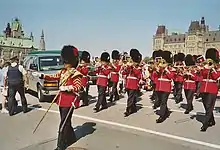
| External video | |
|---|---|
The Ceremonial Guard also maintains its own military band and pipe band that form a separate company. The members of the Band of the Ceremonial Guard (Musique de la Garde de cérémonie) are made up of musicians from the GGFG and the CGG. Musicians are drawn from military units and colleges or universities across Canada, and are auditioned months in advance. All new musicians must pass the Canadian Armed Forces Basic Military Qualification Course (BMQ) before they can be employed with the Ceremonial Guard.
Public duties
The primary and most visible function of the Ceremonial Guard is, as mentioned, the Changing of the Guard on Parliament Hill in Ottawa. The Changing of the Guard Ceremony is a parade representing the changing of the guards/sentries posted at Rideau Hall, the official residence of the Canadian monarch when in Ottawa, and her representative, the governor general, in her absence. The tradition began on Canada Day in 1959 when the 1st Battalion, Canadian Guards, mounted the new guard on Parliament Hill with its band and corps of drums. The ceremony was so popular that the Ottawa Board of Trade asked for permission from the army to continue the ceremony the following year. A full company of two platoons is employed in daily public duties, with both divisions of one platoon parading as the 'new guard' – those to take over duties at Rideau Hall – and the other platoon of the company split, one division parading as 'old guard', and the other performing sentry duties at Rideau Hall and the Tomb of the Unknown Soldier for the day.
Changing of the Guard
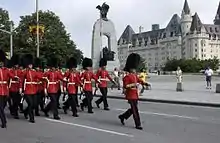
The parade begins at the Cartier Square Drill Hall with the drum major, followed by the band, and the two divisions of the 'new guard'. Turning north onto Queen Elizabeth Drive, the parade continues underneath the Laurier Avenue bridge and then turns left onto the ramp leading onto Laurier Avenue (Ottawa). While the New Guard is en route to Parliament Hill the Old Guard forms up behind the East Block with the colour. They set off at approximately 9:46 a.m. with the Pipes and Drums of the Ceremonial Guard leading. They march to the east lawn and move into position, then they await the New Guard arriving. The New Guard makes a right turn onto Elgin Street up to the National War Memorial and onto Wellington Street before the parade arrives on Parliament Hill precisely at 10 a.m. At this time the band begins to play "The 10 Provinces March" by Howard Cable.
The parade marches onto the east lawn of Parliament, with the band centred at the northernmost edge of the lawn and facing south. The old guard is in position on the west side of the east lawn and faces the east block, while the new guard marches to the east side of the lawn and faces west towards the old guard. After the old and new guards are formed from three ranks into two and independently dressed off for proper alignment, the two sergeants of the guard – commanders of the two divisions of new guard – advance to be inspected by the company sergeant-major. Following inspection, the number two division sergeant marches to his position while the number one division sergeant stands still. The new guard is then given the order "Get on parade", at which point they advance to the tune of "The British Grenadiers" from the band, and form up dressed off the sergeants of the guard. The new guard's persons and weapons are inspected by the company commander, and they are stood at ease.
Following the inspection of the new guard, the old guard is inspected. After this inspection, the sergeants of the guard and division seconds-in-command are ordered to 'take post' – the sergeant of the guard marches from the right flank to directly behind the guard, while the second-in-command marches from the left flank to the right. The parade is then called to the present arms for the marching on of the regimental colours (If the governor general is currently in residence at Rideau Hall, the officers wear a gold sash and march on the Queen's Colour). With the colours marched on, the new guard advances at the slow march, ceremonially 'taking up the ground' from the old guard. The old guard and new guard salute each other at present arms. Following this, the old guard commander presents the key to the Guard Room at Rideau Hall to the new guard commander. The parade is then formed into three ranks and marched off at the slow march, transitioning into the quick march. The order of march differs only in that the old guard is now at the rear.[8]
Sentry duty
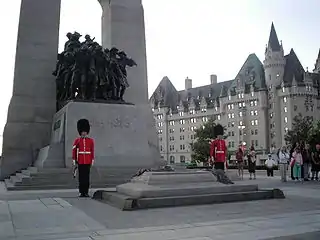
The other highly visible public duty of the Ceremonial Guard is sentry duty at Rideau Hall, as the Canadian War Memorial is sentried by the National Sentry Program. The sentries are ceremonial in nature only and do not generally perform actual guard duty; however, all are trained military personnel and procedures and orders do exist for the Ceremonial Guard to adopt an armed night guard of Rideau Hall should sufficient security threat arise. The sentries at the tomb are part of National Sentry Program (April 9–November 11) of which the CG organizes.
The sentries are posted daily from 9 a.m. to 5 p.m. EDT, every hour on the hour. At 9 a.m. the posting non-commissioned member (NCO) – generally a sergeant or a master corporal but sometimes a corporal from the ranks – marches out accompanied by the two sentries, two escorts, and a bagpiper. The posting NCO, sentries, and escorts are all dressed in full scarlet uniforms and carry rifles with bayonets fixed. The party marches to the Sussex Drive gate of Rideau Hall where the first two sentries are posted and have their duties read to them. The party then marches back to Rideau Hall itself where the two remaining sentries are posted and have their duties read. It should also be noted that the sentries may change more often due to weather issues; e.g. on an extremely hot day.
Throughout the day Rideau Hall is visited by the officer commanding of the parade and the company sergeant-major. They will generally elect to observe a relief of the sentries, and sometimes the officer commanding will take a report from the sentries on duty. The officer and the guard sergeant for Rideau Hall may also elect to do rounds to check on both of the sentry posts. Grand rounds may also be executed by the commanding officer of the unit.
October 2014 Shootings
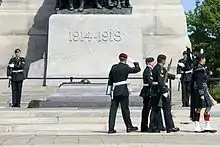
On October 22, 2014, a gunman attacked multiple locations at Parliament Hill.[9] Corporal Nathan Cirillo, a 24 year-old reservist with the Argyll and Sutherland Highlanders of Canada, was standing guard as a ceremonial sentry at the National War Memorial when he was shot with a hunting rifle by Michael Joseph Zehaf-Bibeau.[10] Zehaf-Bibeau fired two shots: One at Cirillo, and one at another sentry, which missed.[10] He then drove to Centre Block, and was subsequently killed in a firefight with Sergeant-at-Arms Kevin Vickers and RCMP Corporal Curtis Barrett.[11] Corporal Cirillo died of his wounds later that day, at the Ottawa Hospital’s Civic Campus.[12]
Extra functions
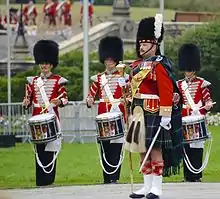
In addition to the Changing of the Guard, the Ceremonial Guard takes part in many other functions, such as the annual Governor General's review of the Guard.[13] This inspection takes place prior to the first Guard mount on Parliament Hill normally in late June, the Canada Day celebration (specifically the noon show) on 1 July, the "Fortissimo" Sunset Ceremony that takes place in late July or early August on Parliament Hill, and the Guard's final parade, Trooping the Colour, at the end of August. It also participates in military funerals (for example, Jack Layton's procession at Parliament), important visits (Queen Elizabeth II in 2010, Duke and Duchess of Cambridge in 2011). The Band of the Ceremonial Guard has many engagements outside of public duties. The Ceremonial Guard's main mission and focus is in Ottawa, the capital city. In between their turns, alongside the regiments forming up the Ceremonial Guard, the Ontario and Quebec area CAF personnel from the Army Primary Reserve regiments stationed in their respective provinces, alongside those from other provinces of the country, handle the guard changing duties only at the National War Memorial, reinforced by the Canadian Rangers and the Royal Canadian Mounted Police, as part of the aforementioned National Sentry Program of the Canadian Armed Forces.
See also
References
- http://www.royalmontrealregiment.com/on-the-hill-rmr-soldiers-parade-with-ceremonial-guard/
- https://www.cbc.ca/archives/when-ottawa-was-forced-to-change-its-changing-of-the-guard-ceremony-1.5169623
- https://ottawa.ctvnews.ca/changing-of-the-guard-on-parliament-hill-cancelled-due-to-covid-19-1.4881936
- "The best military band in Canada is full of purple talent". Archived from the original on 2018-09-06. Retrieved 2018-09-06.
- BAND OF THE CEREMONIAL GUARD CONCERT
- Ceremonial Guard launches its 60th season
- Who forms the Canadian military's ceremonial guard?
- Changing of the Guard
- "Parliament Hill shooting top political story of 2014: exclusive poll". Global News. Retrieved 2020-09-25.
- Gambino, Lauren (2014-10-24). "Canadian police release video of Ottawa gunman during attack". The Guardian. ISSN 0261-3077. Retrieved 2020-09-25.
- "Canada's loneliest hero: Why you've never heard of this RCMP officer who shot the Parliament Hill gunman". National Post. Retrieved 2020-09-25.
- "Ottawa shooting timeline: 10 hours of terror". Global News. Retrieved 2020-09-25.
- https://www.gg.ca/en/activities/2019/annual-inspection-ceremonial-guard
External links
 Media related to Ceremonial Guard at Wikimedia Commons
Media related to Ceremonial Guard at Wikimedia Commons- Official website
- The Band of the Ceremonial Guard
- A Day in the Life of a Ceremonial Guard Musician
- Ceremonial Guard Governor General Address
- Canada's Ceremonial Guard: Inside Ottawa
- Guardsmen train for Parliament Hill’s Changing The Guard ceremony
- Inspection of the Ceremonial Guard by the GG
- 2009 Royal Nova Scotia International Tattoo 23 Canadian Guard Drill
- Paul James Bannerman Drumming in the Band of the Ceremonial Guard in Ottawa 1988